Motion Tracking for Mechanical Load Tests of Gear Boxesand Drive Power-Trains
The components in drive engineering industries need to be tested for numerous mechanical characteristics, e.g. gear boxes need to be checked for long-term smoothness, synchronization, backlash, torsional stiffness, tribological behavior, and/or mechanical resilience. WITTENSTEIN alpha develops and produces mechanical and mechatronic servo drive systems for applications that require maximum precision. The testing facilities of WITTENSTEIN are fitted with vertical, linear motion gearbox test benches.
Since the integrated glass scale is limited in measurement accuracy and bandwidth, WITTENSTEIN uses attocube´s fiber-based interferometer IDS3010, which provides picometer resolution and up to 10 MHz real-time data output. Furthermore, the laser based measurement and the miniaturized components allow to measure as close as possible to the point of interest, without influencing the setups behavior. This enables test and development engineers to determine mechanical and tribological phenomena that could not be detected using conventional glass scales.
This measurement was realized with the Displacement Measuring Interferometer.
High resolution FMCW Radar System
Several industrial progresses, e.g. security or automotive applications, require reliable and high-resolution distance measurements. The group of Nils Pohl at the Fraunhofer Institute for High Frequency Physics and Radar Techniques (Wachtberg, D) and Ruhr-University Bochum (Bochum, D) presented now a fully integrated silicon-germanium based frequency-modulated continuous-wave radar sensor working at 224 GHz with a tuning frequency of 52 GHz. By correcting systematic errors, the outstanding accuracy of the measurement system between -3.9 to +2.8 µm is demonstrated using attocube's laser interferometer FPS1010, a former version of the IDS3010. This high accuracy recommends the radar sensor for multiple applications where radar sensors were not usable before.
This measurement was realized with the Displacement Measuring Interferometer.
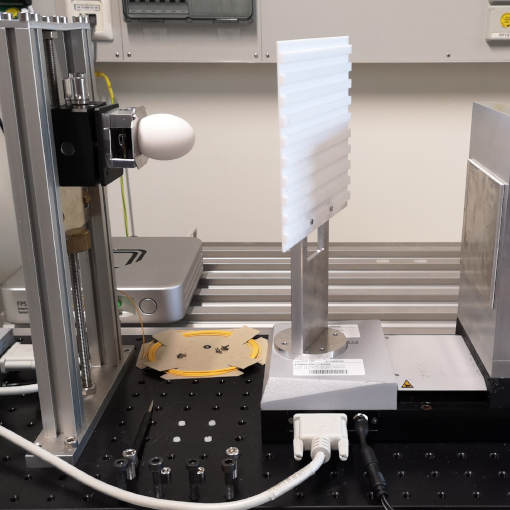
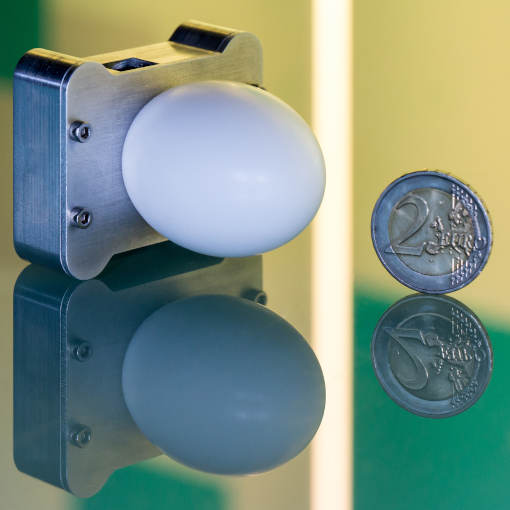
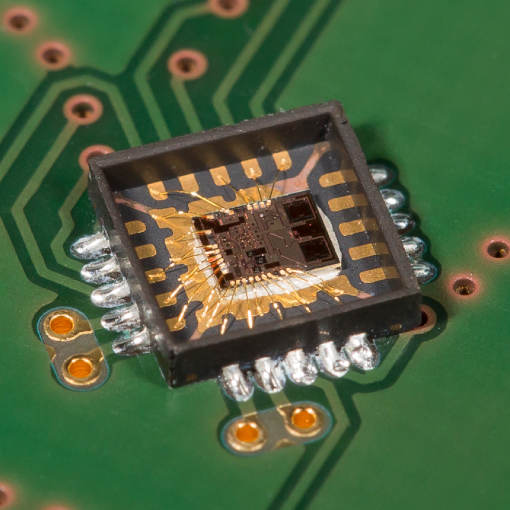
Deformation Detection of Satellite Flight Instruments
The space environment imposes extremely stringent design constrains on observation spacecrafts, especially in terms of thermo-elastic stability, leading to the use of advanced materials and thermal architectures. These constrains also translate into demanding validation processes including accurate characterizations and thermo-mechanical models correlations by means of ambient and high vacuum test campaigns.
OHB system AG used attocube’s interferometric displacement sensor, IDS3010, for an opto-thermo-mechanical model correlation test in high vacuum for the Meteosat Third Generation (MTG) Flexible Combined Imager instrument.
The test consisted in injecting controlled thermal fluxes in different zones of the instrument and monitor its subsequent optical elements relative displacements measured with a Shack-Hartmann sensor. With the precise measurement of the IDS3010 the stability of the relative position of a flat reference mirror and the IRS instrument was continuously monitored with an accuracy of less than 1 arcsecond during the whole duration of the test which lasted more than a week in vacuum in total.
This measurement was realized with the Displacement Measuring Interferometer.
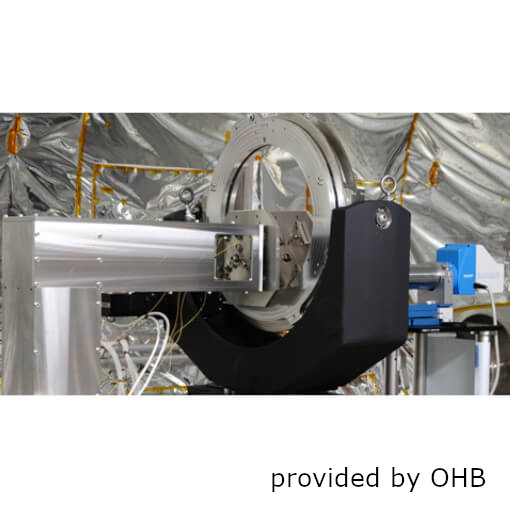
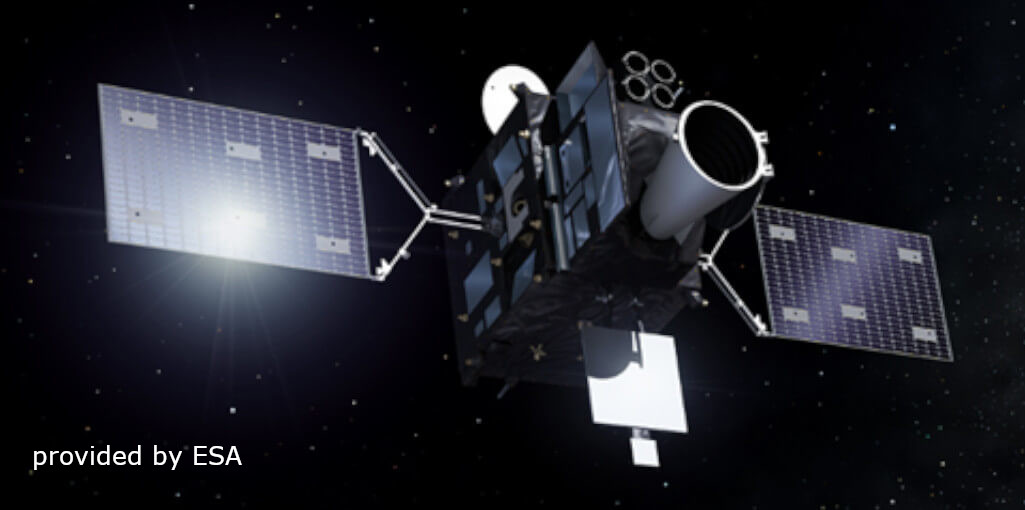
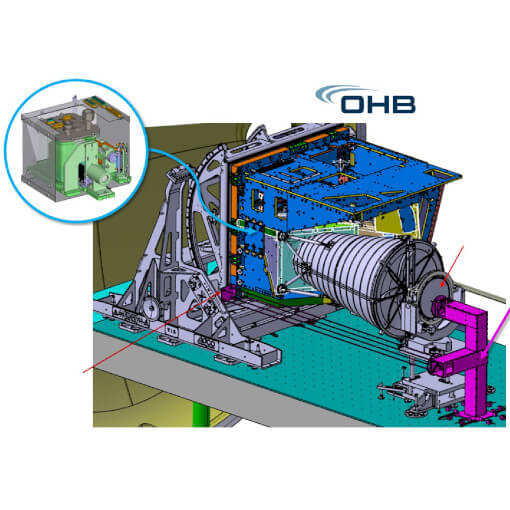
Measuring the Deformation of a Magnetically Levitated Plate
Deformations in lightweight moving structures such as the wafer stages in semiconductor lithography systems hinder the fabrication process with a high throughput rate. To compensate these deformations, accurate measurements are required. C. H. H. M. Custers and I. Proimadis at the Eindhoven University of Technology (NL) designed a prototype based on attocube’s interferometer IDS3010 to study these properties in more detail. A grid of 5 x 5 M12/F40 sensor heads detects the deformation of the mover inside a bearingless planar motor with nm accuracy. By accurately detecting the induced deformation, the goal of the experiment was the active attenuation of the deformation by properly shaping the force distribution on the magnetically levitated translator.
This measurement was realized with the Displacement Measuring Interferometer.
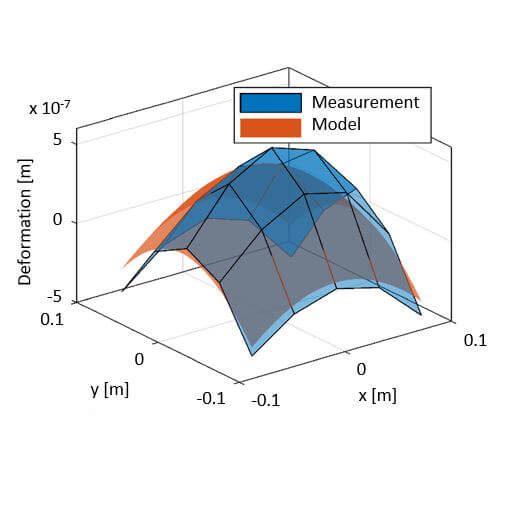
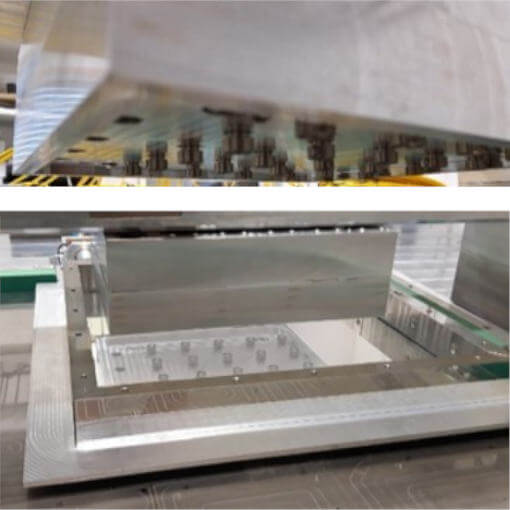
Ultra Precise Motion Tracking in Multilayer Zone Plate Imaging
In hard X-ray imaging, the average scanning time per probe is an essential parameter to reduce beam damage spreading. In addition, the real-time resolution can be strongly affected by vibration or drift of the setup. In ptychographic experiments like crystallography, the scanning time mainly depends on the setup’s stability.
attocube's interferometer FPS3010, a former version of the IDS3010, was used to optimize the stability of a newly developed experimental setup composed of Multilayer Zone Plate (MZP) optics as well as a MZP based piezo sample scanner. This was tested at the P10 beamline at the PETRA III synchrotron (DESY Photon Science).
The interferometer detected crosstalk generated by vibration and shocks caused by sample alignment motors. Based on these measurements, the setup’s imaging resolution was reduced down to +/-10 nm.
This measurement was realized with the Displacement Measuring Interferometer.
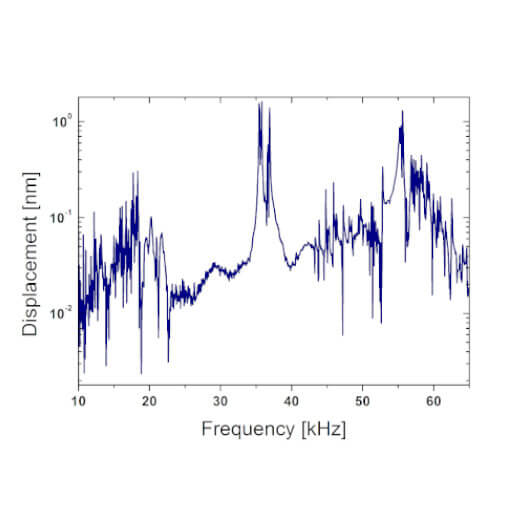
IDS3010 Detecting Vibrations with Picometer Resolution
The renowned science journal “Nature" has recently published an article describing the experimental observations of a two-dimensional quantized quadrupole insulator. In these experiments, performed at the Institute for Theoretical Physics of the ETH Zürich, attocube's interferometer IDS3010 was used for vibration analysis of a mechanical metamaterial after exciting with an ultrasound air transducer.
The IDS3010 identified small vibrations at different locations of the mechanical metamaterial to identify the resonant frequencies. The small error estimate of 11.2 pm enables comprehensive results in the experimental analysis of phononic quadrupole topological insulators.
This measurement was realized with the Displacement Measuring Interferometer.
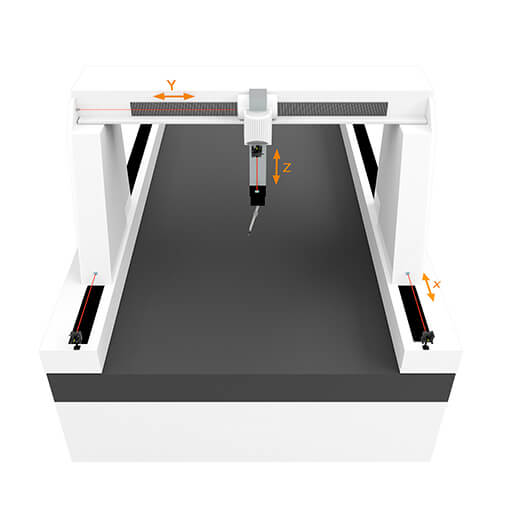
Fast Calibration of Machine Tools based on the IDS3010
Researchers at the Chair of Production Metrology and Quality Management at the Laboratory for Machine Tools and Production Engineering (WZL) of RWTH Aachen University investigate the possibility of self-calibrating machine tools: a laser interferometer and other sensors will be integrated into a machine tool for automated online measurements of the axes' motion errors. This makes time-consuming manual calibrations redundant that require to interrupt the production process and to install and to demount the calibration equipment.
The researchers built a prototype for a single-axis setup that utilizes the IDS3010 for position tracking. Other sensors like a CMOS camera were used to detect pitch and yaw. The calibration results were compared to the results of a conventional calibration system: while the six motion errors (position, pitch, yaw, y-straightness, z-straightness) show a good agreement for both systems, the total time and costs where significantly lower using the IDS3010. The setup demonstrated a first prototype for a self-calibrating machine tool and shows that an automated procedure reduces machine downtimes, thus enhancing productivity by keeping the same level of accuracy.
This measurement was realized with the Displacement Measuring Interferometer.
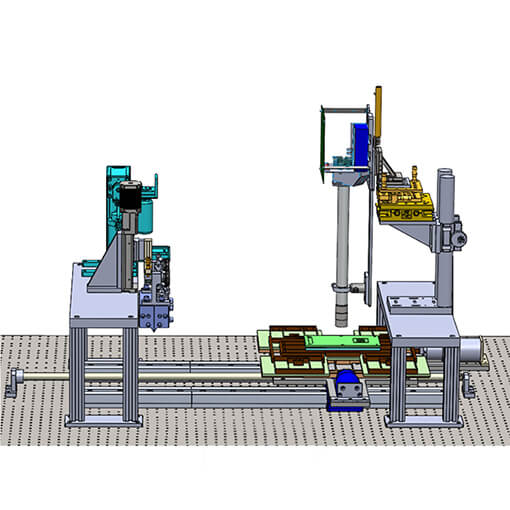
Displacement Sensing in Additive Manufacturing with attocube's Interferometer
An innovative method for manufacturing integrated circuit package building blocks (e.g. microcontrollers) is the so-called micro-scale selective laser sintering (µ-SLS). Additive manufacturing is state-of-the art in many engineering applications requiring accuracy in the micrometer range. However, the production of integrated circuit packages are in dimensions on the order of a few micrometers and need smaller tolerances than conventional additive manufacturing methods can provide.
The University of Texas and the company NXP Semiconductors have developed a new 3D printer based on the µ-SLS technology for manufacturing integrated circuit packages. This system includes an air bearings linear guide rail for transporting the work piece between the sintering station and the slot die coating station. Since this guide rail has highest requirements on position accuracy, attocube's interferometer is used for position tracking.
This measurement was realized with the Displacement Measuring Interferometer, and the .
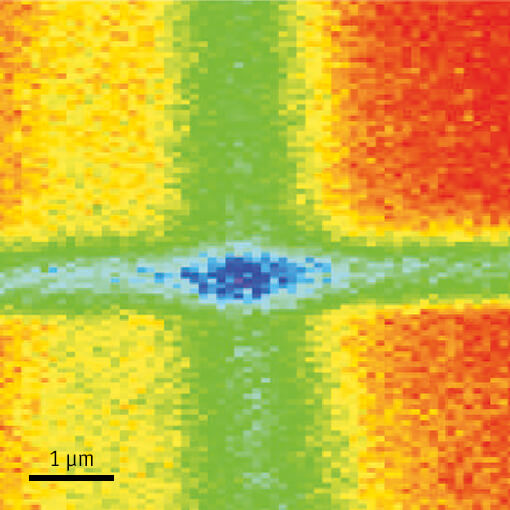
Characterizing a scanning fluorescence X-ray microscope
When developing an X-Ray microscope capable of nm resolution, careful design is a must. Thermal and mechanical stability of the components and assemblies has to be followed throughout the process. The FPS shows superior performance regarding its outstanding stability and its capability of measuring sub-nm displacements. The senor has a better than 1.25 nm stability over 40 hours, and a better then 300 pm resolution at 100 Hz bandwidth in a controlled environment. The FPS is therefore the ideal supplement for the mechanical control of all components used in the described X-Ray microscope setup achieving a resolution in the order of 40 nm, while the stability is below 45 nm over the entire time needed for data collection.
This measurement was realized with the Displacement Measuring Interferometer.
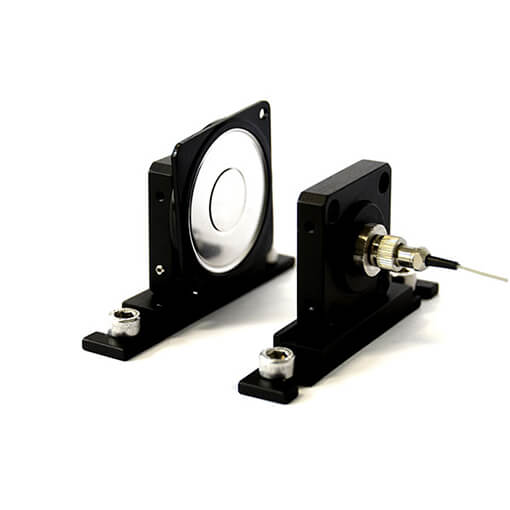
Measuring a speakers‘ frequency response using the interferometric sensor
Only recently, attocube released the new FPS3010, which is even more integrated and automated as previous versions. Here, the FPS3010 was used to measure the displacement of a speakers’ membrane to characterize its frequency response. The setup is shown in Figure 2.
The new FPS3010 has outstanding properties such as a measurement bandwidth of 10 MHz. At the same time, the alignment restrictions for the optical sensor are relaxed, due to a large acceptance angle of ±0.4°. This makes the FPS3010 usable in a wide range of applications. The standard version is equipped with three sensor channels for the detection of e.g. linear movement together with pitch and yaw or 3D motion.
This measurement was realized with the Displacement Measuring Interferometer.
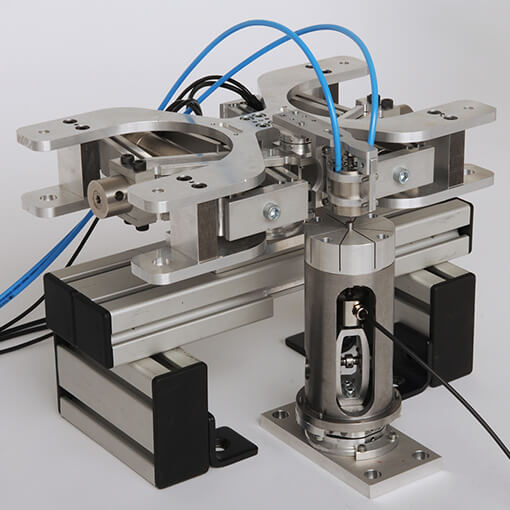
Fiber based laser interferometry stimulating the development of highly precise micro manufacturing
Ultra-precise and contactless surface analyses are of major interest in order to guarantee the quality of the material in many research and industrial applications. The large acceptance angle is one of the main strong benefits of attocube’s Industrial Displacement Sensor (IDS). Due to its proprietary patented techniques, the system allows for measurements on surfaces with more than 10° inclination with respect to the measurement direction. The actual measurement shows nanometer precise 3D profilometry data of micron-sized metal cylinders. Several deformations can be seen: In the center position the object profile clearly shows a dent on its surface with a depth of around 400 nm. In addition the diameter contour in the front part near x = 0 has a plateau over a length of approximately 10 µm.
This measurement was realized with the Displacement Measuring Interferometer.
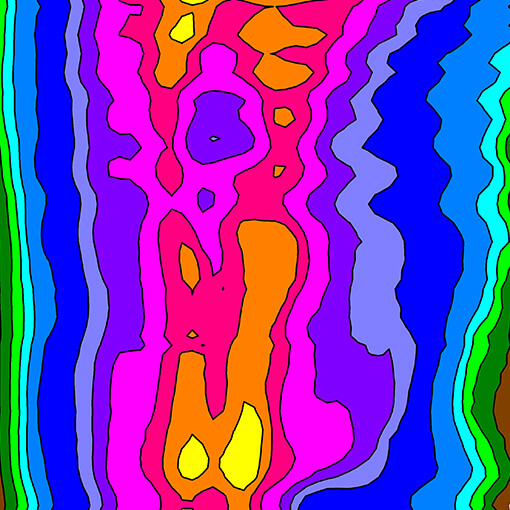
3D Profilometry of Micrometer-Sized Cylinders
In many research and industry applications, ultra-precise and contactless surface analyses are a key factor in order to guarantee the quality of the material under investigation, as well as to detect even the tiniest contour deviations of the material.
Especially when measuring on micron-sized objects, accurate alignment of the sensor head can be very difficult. With attocube’s fiber-based interferometer and the newly introduced D12/F2.8 sensor head, these measurements can now be performed easily.
This measurement was realized with the Displacement Measuring Interferometer.
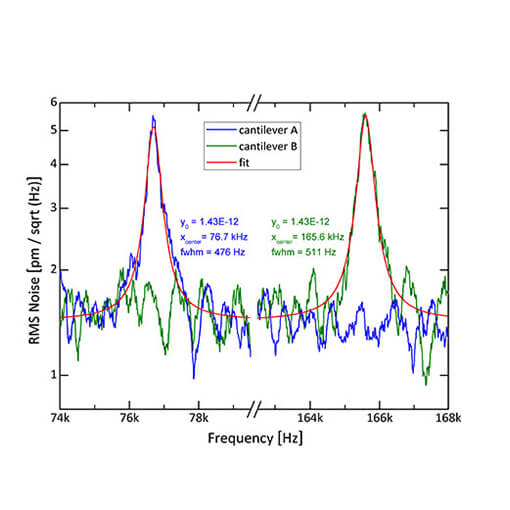
Measuring Brownian Motion of Comercial Micro-Cantilevers
Frequency analysis is a standard method to study demanding applications and measure the frequency dependent mechanical motion of e.g. micro- or nanomechanical systems (MEMS / NEMS). Measuring vibrations with amplitudes of only few picometers is very challenging, exceeding the capabilities of other commercially available measurement techniques.
To demonstrate that attocube’s fiber-based Displacement Sensor (IDS) not only has high-resolution but also a very low noise floor, we measured the resonant vibrations of micro-sized cantilevers which were excited only by their thermal energy at ambient conditions.
This measurement was realized with the Displacement Measuring Interferometer, and the .
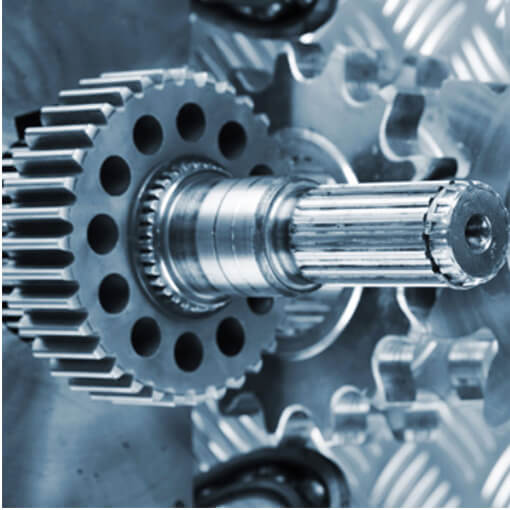
Contactless Frequency Analysis of Motor Vibrations
Machine vibrations induce errors in parts manufacturing. The miniscule vibrations of a milling machine produce erratic motions of the workpiece with regards to the cutter and hence, may lead to contouring errors or a bad surface finish. Such defective parts create problems and can jeopardize the whole system’s assembly or safe operation. In the end, they may fail quality criterions such as the 6-sigma standard. Get our latest application note & see how the FPS3010 can help to efficiently and precisely characterize vibrations, thus helping to succesfully eliminate these errors.
This measurement was realized with the Displacement Measuring Interferometer.
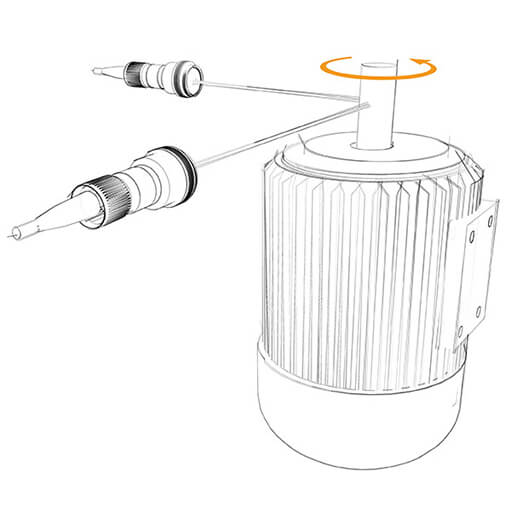
Ultra-precise contactless detection of bearing errors
To monitor the health status of a gear or machine, attocube’s IDS3010 can be used to track machine vibrations. To improve the vibration behavior of a machine, its motor was rotated at different speed levels and the motor’s vibrations were measured on the outer shell of the motor. Conducting a live Fast-Fourier-Transformation (FFT) showed that the motor rotating with 2000 rpm generated vibrations at 270 Hz which in turn amplified a system resonance at 345 Hz, and therefore drastically increased the overall vibration amplitude. At this system status, the vibrations amplitude was identified to be more than 150 nm, while the maximum acceptable amplitude was set to 100 nm. This crucial information enabled the system’s manufacturer to minimize the system response to vibrations and prevented potential failure.
This measurement was realized with the Displacement Measuring Interferometer.
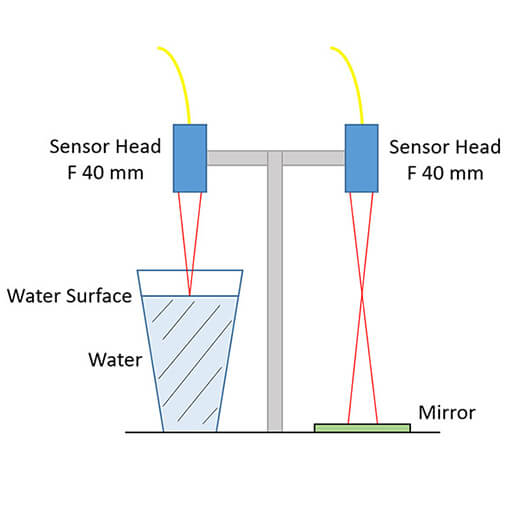
Displacement Measurement on a Water Surface
To measure the displacements of a cup’s water surface compared to the displacements of the table the cup is positioned on, two focused sensor heads were used: one of them focused on the water surface, the other focused on a mirror fixed to the table, while the table was hit by a hammer. The water surface oscillates with a maximum deflection of approximately ± 20 µm and the table oscillates with a maximum amplitude of around ± 0.7µm. The zoom highlights that the two measurement arms show similar behaviors in the high frequency range for the first milliseconds after the excitation.
This measurement was realized with the Displacement Measuring Interferometer.
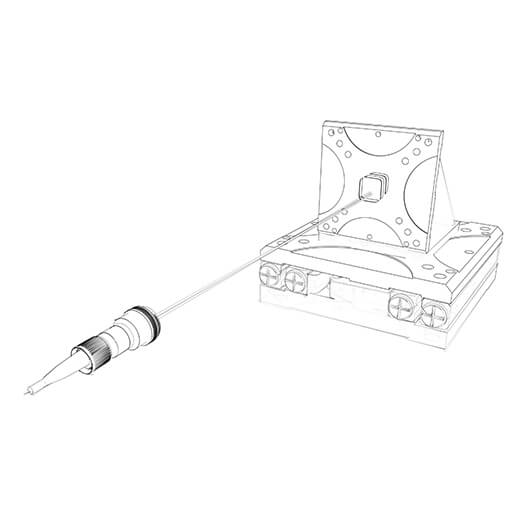
Optical Interferometer in Quality Control of a Nanopositioner
We've combined two of our products to ensure the highest quality delivered to our customers: In this application note we show the implementation of the FPS3010 interferometer in the quality control process of our nano drives. The outstanding precision of the FPSensor will ensure that every positioner delivered fulfills the highest quality standards, whereas the easy & robust alignment of the sensor permits high throughput, and therefore reduced lead-time.
This measurement was realized with the Displacement Measuring Interferometer.

Nanometer Precise Positioning During Sample Rotations
Synchrotrons are electron particle accelerators that provide high-brilliance x-ray beams for experimental end-stations where it is used to study properties of different materials. These x-rays, having high penetration capabilities and highly focused beams, are often used in image scans where motion positioning systems play a primal role.
X-ray nano-imaging necessitates positioning systems with high constraints in mechanical construction as well as position metrology. In-axis and crosstalk motion errors, from linear as well as rotational drives, are always present and notably troublesome at nanometer-precision scans. Rotational drives are particularly difficult to characterize in respect to axial runout and wobble.
This measurement was realized with the Displacement Measuring Interferometer.
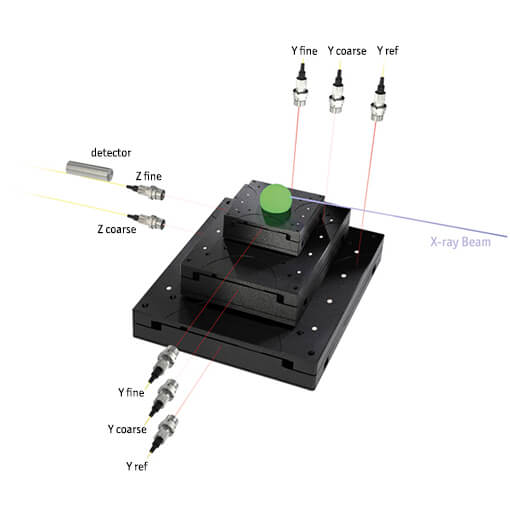
Detecting vibration propagation and parasitic motions with picometer resolution
Exact sample positioning in synchrotron beamlines requires position detection with highest resolution. A group at the Diamond Light Source designed a sample positioning system with three positioners for x, y, z movements. To determine the error motions, eight axes of three IDS3010 devices were triggered for synchronous data acquisition, controlling the movement with BiSS-C interface. They identified parasitic motions of only 100 pm that were caused in the non orthogonal fixing of the positioners. These smallest amount of deviation can be detected in Ultra-high vacuum only - and with the IDS3010.
(Trevor Bates, Brian Nutter, Diamond Light Source Limited, Oxfordshire, England)
This measurement was realized with the ECSx5050/Al/RT, and the Displacement Measuring Interferometer.
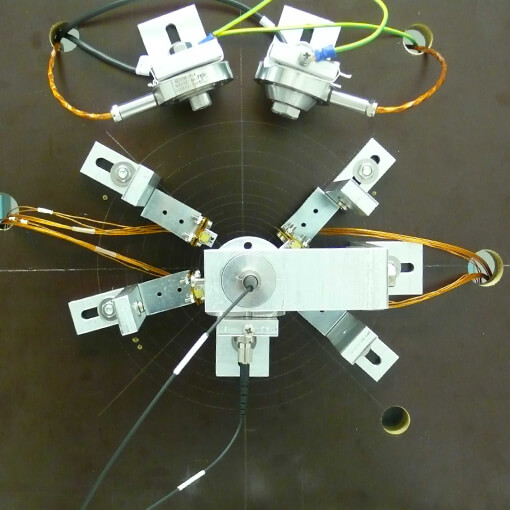
Laser Interferometry in Radiation Harsh Environments
attocube’s award winning FPSensor is now available with radiation hard sensor heads. Among the existing sensor portfolio, the “M12”sensor head has been qualified for the operation in radioactive environments at radiation doses of up to 10MGy.
The qualification process was conducted using a Co60 source and was succsefully tested by CERN and Fraunhofer Institute.
This measurement was realized with the Displacement Measuring Interferometer.
Vibration of high-power precision laser mirror
At the “ELI Beamlines facility”, currently under construction in Dolní Brežany close to Prague in the Czech Republic, we have developed an ultra-high pointing stability laser mirror mount for guiding the world’s highest repetition rate HAPLS Petawatt laser over up to 107 meters onto the target. The attocube IDS3010 offers major advantages compared to standard sensors like capacitive probes and accelerators when measuring 5 - 100 nrad RMS pointing stability of a mounted high-power precision laser mirror. While accelerometers may be used to measure mirror dummies for frequencies >≈12 Hz, the IDS3010 interferometer may diagnose contactless sub-nm displacements up to 10 MHz of mounted mirrors without risking the degradation of its laser damage threshold. In addition the IDS3010 sensor allows working distances up to a few meters. The software WAVE has proved to be convenient for visualizing in real-time the displacement data and for identifying resonant frequencies.
(Dr. Tomas Laštovicka, Dr. Martin Sokol, Dr. Michael Morrissey, Ing. Antonin Fajstavr, Dr. Stefan Borneis ELI-Beamlines, Dolní Brežany, CZ)
This measurement was realized with the Displacement Measuring Interferometer.
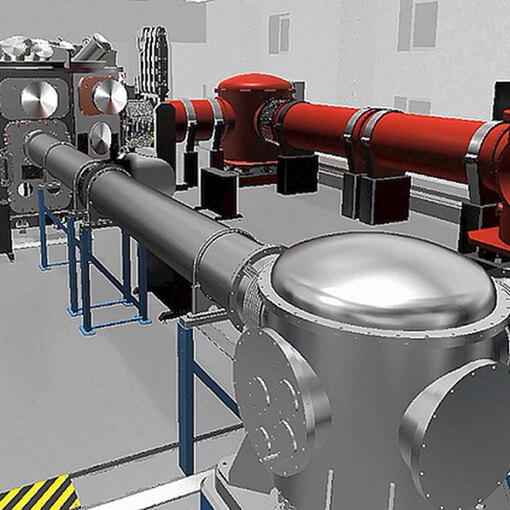
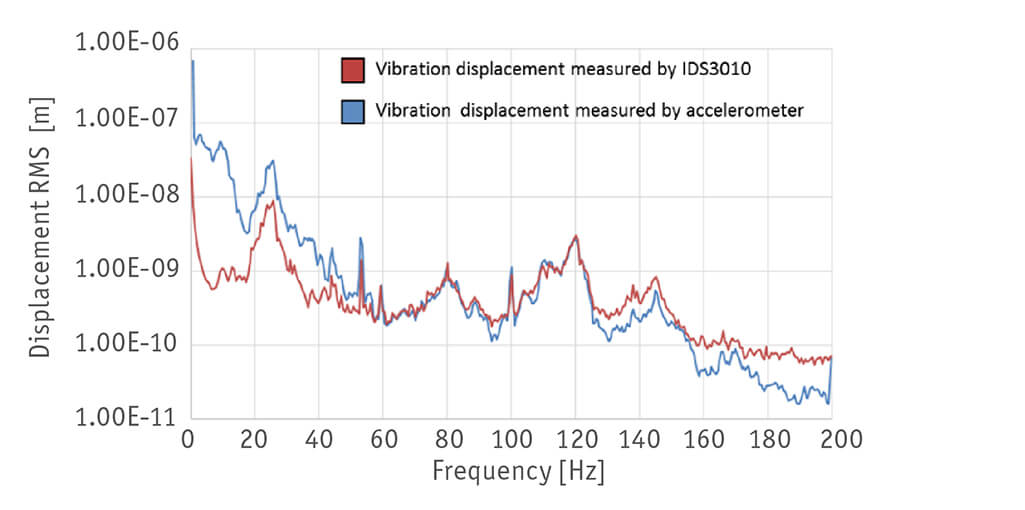
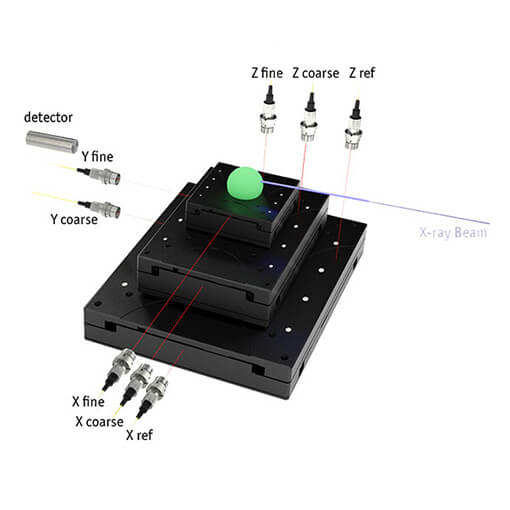
Interferometric Multi-Axis Motion Control of an X-Ray Setup
In high precision systems for moving objects in nanometer ranges, error motions and vibration propagation are crucial information for the motion accuracy. Due to this, synchrotron facilities continue to develop and upgrade different components to keep pace with the latest available technologies. The beamline I08 recently upgraded the end-station using attocube interferometers IDS3010 with BiSS-C interface. An experimental setup at the Diamond Light Source is synchronously triggering and tracking the movement of eight different linear axes. These eight axes were controlled by the Delta Tau “GeoBrick” controller, which ensures the accurate timestamped data from all eight axes, i.e. three IDS3010 devices.
The setup consists of three motion modules as shown in a simplified version in the upper figure: from the bottom one manual positioner, on top of it one stepper motor for more coarse adjustments, and finally on top of that one piezo-based positioner for fine motions. All three modules can move in X-, Y-, and Z-direction, i.e. the complete setup consists of 9 linear movements, and is being tracked by 8-axes consisting of M12/C1.6 high vacuum compatible sensor heads. Since the sample’s position is relevant for each movement of the three modules, every motion axis needs to be tracked. There are two kinds of error motions (parasitic movements) relevant for the sample’s position: vibrations caused by moving the positioner that spread to connecting positioners and the sample, as well as uneven motions caused by non-parallel mountings between the positioners.
One measurement example is shown in the lower figuer, which only involves the X, Y, and Z piezo-based positioners in the upper module. The two parasitic movements are shown while moving the fine piezo positioner in the X-direction using 5 nm step sizes. The red line (X-axis) shows the positioner moving in one direction, after 10 steps, the positioner is moving back with one 50 nm step. The blue line (Y-axis) shows the error motions of the fine positioner orthogonal to the motion of the positioner in the horizontal level. The noised oscillations are caused by vibration propagation emerging from the positioner’s motions. This line shows a linear offset of 10 pm for every step. This offset originates from the not perfect parallel mounting between the X- and Y- positioners. This non orthogonal mount can be compensated using the information for the other axes. The green line (Z-axis) shows the vertical movements of the fine positioner. Only the last step of 50 nm shows a significant change of the vertical position, presumable due to a rapid vibration.
(Diamond Light Source Limited, 2017)
This measurement was realized with the Displacement Measuring Interferometer.
Rotation motion error compensation for stable probe positioning
The challenge of rotatory probe positioning for x-ray nanotomography is the limited tolerance of the runout. The smaller the runout - the better the resolution of experiments. The closed loop system at the synchrotron SOLEIL consists of a positioning stage for rotating the probe and attocube‘s interferometer focusing directly on the rotating cylinder. The positioning stage is equipped with three linear drives, two piezo driven positioners for compensation of error motions, and one rotational stage. Based on a reduction algorithm for error motions, the initial runout of 1250 nm is reduced to 42 nm - a decrease of 97%.
(Christer Engblom, Synchrotron Soleil, St Aubin, France)
This measurement was realized with the Displacement Measuring Interferometer, and the .
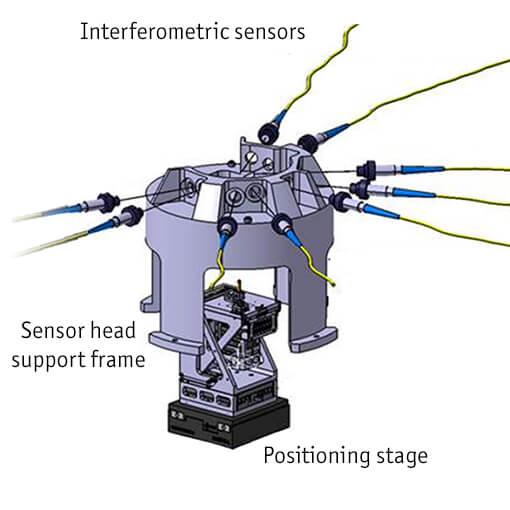
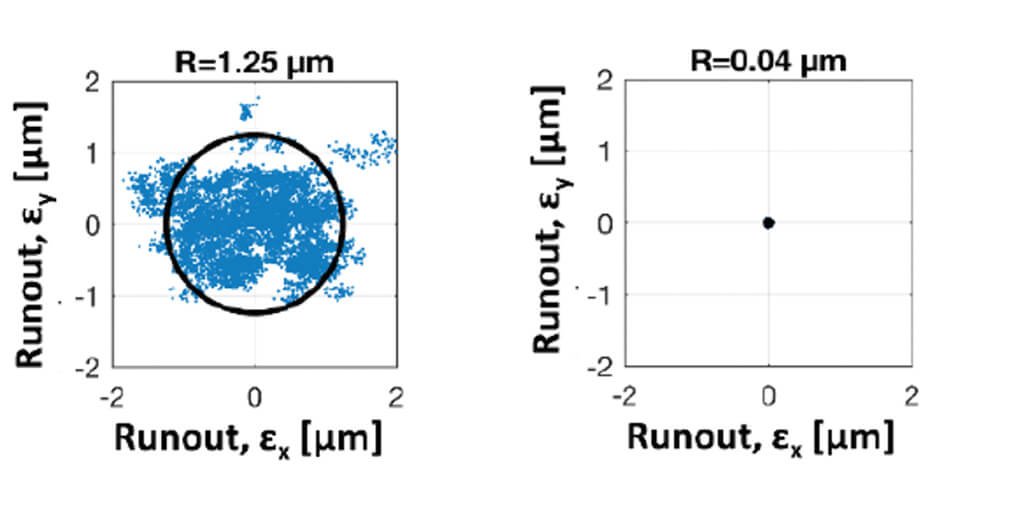
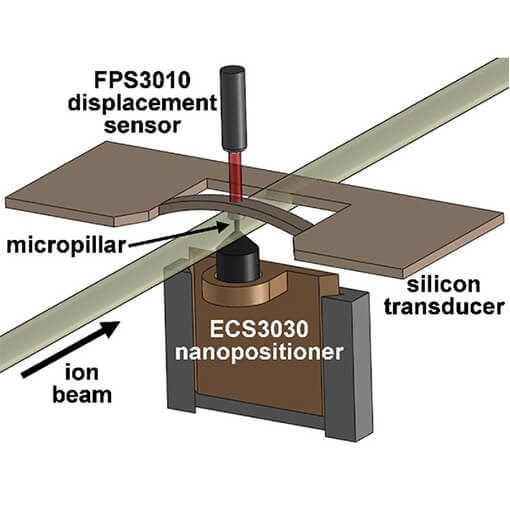
Measurements of Irradiation-Induced Creep
S. Özerinç and his colleagues at the University of Illinois at Urbana-Champaign have developed an apparatus for measuring irradiation induced damage and stress on the nanometer scale. Using attocube's ECS3030 as well as the FPS3010 interferometer, the system can measure in situ the deformation of mechanically stressed micro-pillars, during which the pillars are irradiated with heavy MeV ions. The apparatus provides a new and effective approach to accelerate the evaluation of promising materials for future nuclear power plant applications.
This measurement was realized with the ANPx101/RT - linear x-nanopositioner, and the Displacement Measuring Interferometer.
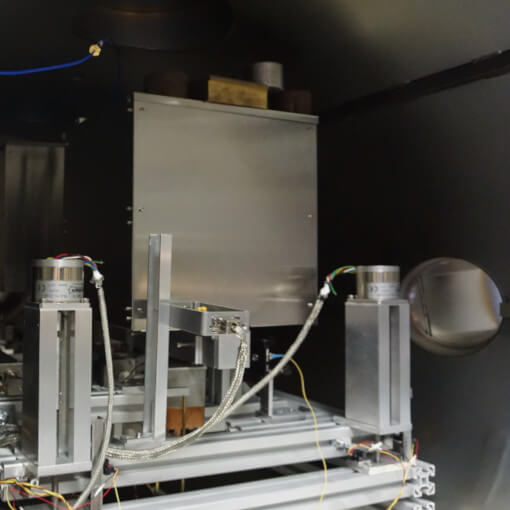
The SpaceDrive Project - The IDS3010 to gauge a thrust balance in the sub-µN range
Interstellar travel is one of mankind's biggest dream. An ongoing and so far unanswered challenge is the search for an engine, capable of accelerating a rocket to a velocity, which allows us to reach the next star within a lifetime. The basic concept is that for the acceleration no huge trust is necessary as long as it can be supplied continuously throughout the whole travel. A key element of the quest is a propellantless engine, in other words, one that is not based on a momentum generated by ejecting some material, the propellant.
The two currently most researched ideas are the EMDrive and the Mach-Effect Thruster. So far there is no convincing experiment that proves or disproves either concept. A crucial element of this research is a tool to measure extremely small forces (the thrust generated by an experimental sized engine) in a perfectly isolated environment, where all other effects can be eliminated.
The Group of Maxime Monette is developing one such setup by putting a ultra-precise torsion pendulum into a large vacuum chamber and measuring its movement with pm resolution using attocube's IDS3010 interferometric displacement sensor, as shown on the picture. Thanks to their clever design and the pm resolution of the IDS3010 they were able to achieve sub-Nanometer resolution in a UHV environment without introducing any electronic or mechanical noise.
This measurement was realized with the Displacement Measuring Interferometer.
Further reading:
Martin Tajmar et al; SP2018_016
Ultra-wide frequency range vibrometry
The FPS sensor is not only a very capable real-time displacement sensor but it also serves the user as a powerful vibrometer. With its built-in fast-Fourier algorithm (FFT), the FPS series directly detects the distribution of vibrational modes/amplitudes in frequency space. Frequency and phase information of resonance peaks can be live-viewed on the PC-based FPS application software. The data above demonstrate the suitability of the FPS sensor for this type of application. In this specific case, the low-frequency noise behaviour of the FPS sensor was tested by exciting and measuring the vibration spectrum of a ceramic piezo at low frequency and ultra-low amplitude. As can be seen from the data, the noise floor of the measurement is at 1E-6 µm equivalent to 1 picometer. Stunningly, this noise floor extends to very low frequency, enabling picometer resolution at frequencies as low as 2 Hz. Data are recorded at 100 Hz bandwidth.
(attocube applications labs, 2014)
This measurement was realized with the Displacement Measuring Interferometer.
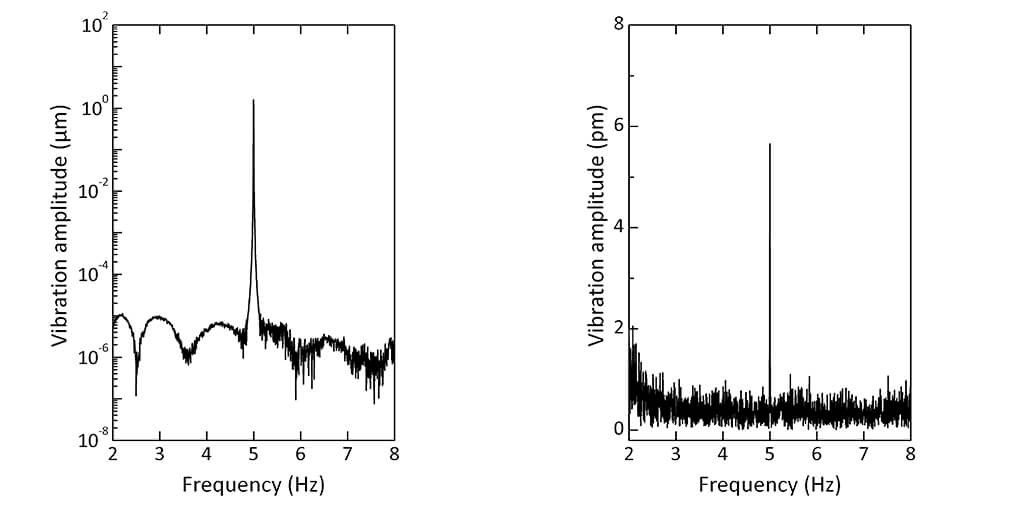
OEM Interferometers for motion tracking in coordinate measurement machines
Coordinate measurement machines (CMM) have highest requirements towards precision. CMM determine geometrical dimensions of simple and complex products and components for quality control (e.g., measurements of manufacturing accuracy or tribological measurements). Those applications require an accuracy in a sub-micrometer range, while the calibration and the machine-integrated control need a higher level of accuracy.
The laser interferometers of attocube are solutions providing highest precision and large working distances at the same time - suiting the challenging requirements of CMM. While the IDS3010 allows to measure displacements of up to 5 meters, it simultaneously detects overshoots in the nanometer range. Furthermore, the compact design of the IDS3010 and the sensor heads fits machine-integrated applications.
Customers can choose:
- target velocity up to 2m/s
- direct beam or mirror deflection
- Workings distances of up to 5 meters with a constant precision in nanometer range
- In situ measurements on the touching probe without Abbe errors instead of mechanically transmitted position acquisition (e.g glass-scales)
- Compact interferometer unit for machine-integration
This measurement was realized with the Displacement Measuring Interferometer, and the .
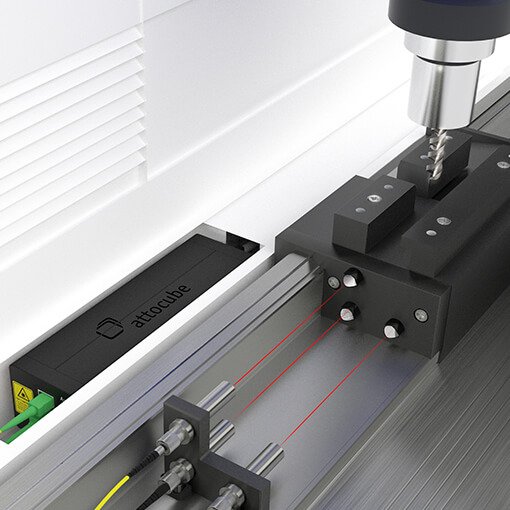
Ultra Precise In-Line Travel Property Control
In many industrial processes, motion and accuracy of motion are of utmost importance. This is true for machining processes (e.g. ultra-precision machining), wafer processing and inspection, metrology measurements, and many other applications.
For this purpose, attocube has designed a three-axis miniature laser interferometer, which provides ultra precise real-time measurement of linear target motion as well as analysis of parasitic pitch and yaw motions. If embedded in a closed loop circuitry, motion in three degrees of freedom can be controlled down to the nanometer scale.
Customers can choose:
- sensor head diameter from 1 mm up to 15.5.mm
- distance sensor head to target from 0 mm to > 1 meters
- target velocity up to 2 m/s
- direct beam or mirror deflection
- customized housing
This measurement was realized with the Displacement Measuring Interferometer, and the .
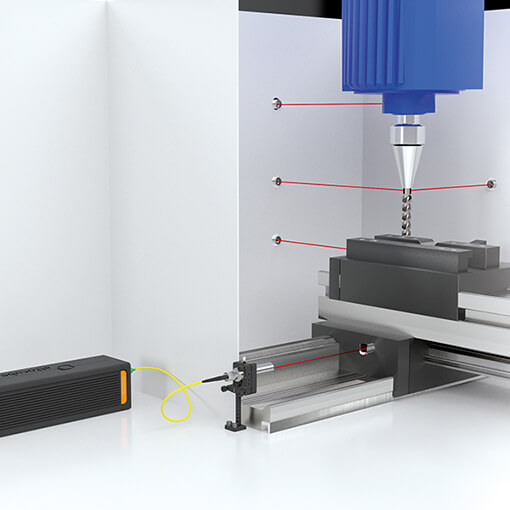
Machine Integrated Sensors for Motion Capturing
The growing demand for high accuracy position sensing in machine tools requests cost efficient yet flexible sensors with high resolution at potentially large working ranges. Up to today, interferometry has been well known for highest accuracy but also high costs and demanding space requirements, making it unattractive for mass application and machine integration.
attocube's IDS3010 now solves this challenge: the ultra compact OEM interferometer is an economic solution and optimized for machine integration with unrivaled optical performance. Especially for applications exceeding the specifications of industry-wide used glass-scales, the IDS3010 is capable of capturing motions more accurate than other measurement systems.
Customers can choose:
- a wide range of interfaces (analog sin/cos, digital incremental, field busses)- various sensor head designs for environments ranging from low temperature to 400°C. sensor head diameter from 1 mm up to 15.5 mm
- distance sensor head to target from 0 mm to > 5 meters
- target velocity up to 2 m/s
- direct beam or mirror deflection
- customized housing
This measurement was realized with the Displacement Measuring Interferometer, and the .
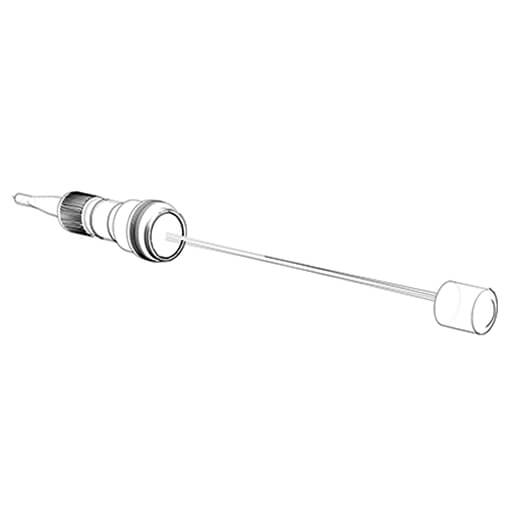
Long distance and high-speed displacement measurements
Machine vibrations induce errors in parts manufacturing. The miniscule vibrations of a milling machine produce erratic motions of the workpiece with regards to the cutter and hence, may lead to contouring errors or a bad surface finish. Such defective parts create problems and can jeopardize the whole system’s assembly or safe operation. In the end, they may fail quality criterions such as the 6-σ standard. Get our latest application note & see how the FPS3010 can help to efficiently and precisely characterize vibrations, thus helping to succesfully eliminate these errors.
This measurement was realized with the Displacement Measuring Interferometer.
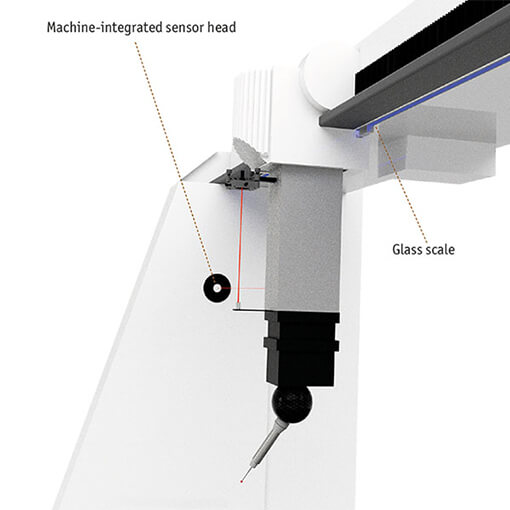
Position Capturing in Coordinate Measurement Machines
Cordinate measurement machines (CMM) measure more than just distances, they are capable of capturing a broad range of geometries: angles, profile of a surface, parallelism, symmetries, tolerances, circularity, and much more. For those applications, CMM provide an accuracy in a sub-micrometer range. To enable this level of accuracy, CMM need even more accurate sensors to be calibrated.
Since glass-scales do not measure the displacements of the touch probe itself, they cannot detect the actual overshoots and motion of the touch probe. Because of the contactless measurement technology, attocube’s IDS (Industrial Displacement Sensor) is capable of focusing on the touch probe directly and capturing the motions at the point of interest.
This measurement was realized with the Displacement Measuring Interferometer.
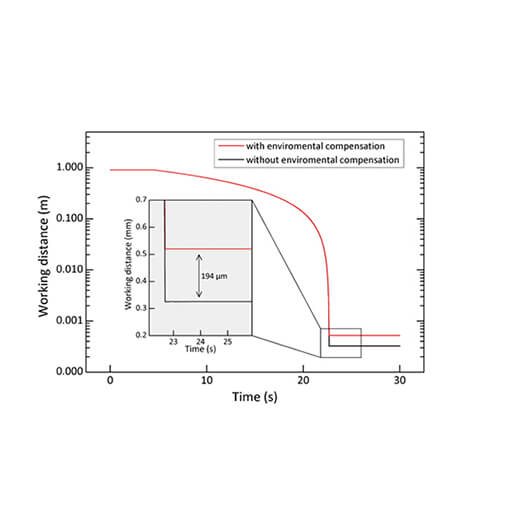
Environmental Compensation
Any interferometric device operated in environmental conditions is negatively influenced by index of refraction fluctuations, caused by air temperature, pressure, and humidity variation. The influence of these parameters is significant and can reach deviations in measurement of up to 500 ppm, equivalent to a deviation of 500 µm per meter.
To compensate these errors, attocube offers an environmental compensation unit (ECU) which precisely measures environmental parameters and determines the actual index of refraction n(t). This measurement allows to compensate environmental influences down to better 1 ppm and enables highly precise, accurate measurements in air.
(attocube application labs, 2017)
This measurement was realized with the Displacement Measuring Interferometer.

